
Over the past year, we’ve been talking to thousands of people about the power of using conversations (not forms) to capture and qualify leads.
Looking back, one thing has become clear:
People get it.
Across the board, people are frustrated with the traditional approach and the traditional buying experience, and more and more of them have been gravitating toward conversational marketing.
But there’s still one question we continue to hear more than anything else:
How do YOU do conversational marketing? How do YOU capture leads and book qualified meetings for your sales team at Drift without using gated content and lead forms?
Well, since we’re all about making content and information free, we figured we couldn’t make an exception here.
So here we go: I’m going to walk you through every Playbook the Drift marketing team runs on Drift.com, and teach you how to get the same Playbooks set up on your site.
This is how we use Drift at Drift.
1) Get a Demo
Where we run this Playbook:
- Drift.com homepage
- Across the Drift.com website
When it displays:
- After someone clicks our “Get a Demo” button
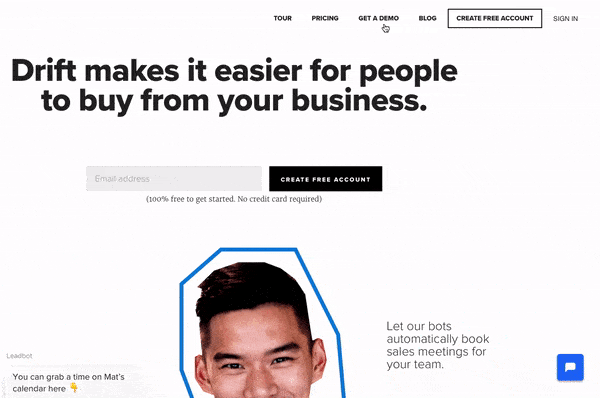
Go to any B2B or SaaS website and you’ll inevitably find a “Contact Sales” or “Get a Demo” button. But as a lead, when you click that button, guess what happens?
In most cases, you get sent to a landing page form, where you have to enter in a bunch of your contact information and then wait — sometimes hours, sometimes days, sometimes weeks — for a sales rep to get back to you.
☝ That’s a terrible buying experience. And that’s why we — and a lot of our customers (see Tweets below) — have started replacing demo forms with chatbot-powered Playbooks that can automatically qualify leads and book demos for sales in real-time.
Just set up an Assertible demo for a F500 company in seconds with @drift ??⏲ Imagine if they had to use the “Contact us” form!
— Cody Reichert (@CodyReichert) August 11, 2017
So @drift booked 80 pre-qualified demos for us in July (so far). Big part of that is the Playbooks (chatbot) feature. That’s nuts!
— Scott Magdalein (@ScottMagdalein) July 31, 2017
At Drift, our sales reps love this Playbook because they can literally walk into work in the morning and find demos waiting for them on their calendars.
From a setup perspective, there’s no technical experience needed. (Case in point: I built our “Get a Demo” Playbook at Drift, and I have zero coding skills.)
To get this Playbook running on your website, first you’ll need to select the “Book a Qualified Meeting via LeadBot” Playbook from the Playbooks dashboard. Then you’ll need to write a greeting and a few qualifying questions — the same questions your sales reps would ask.
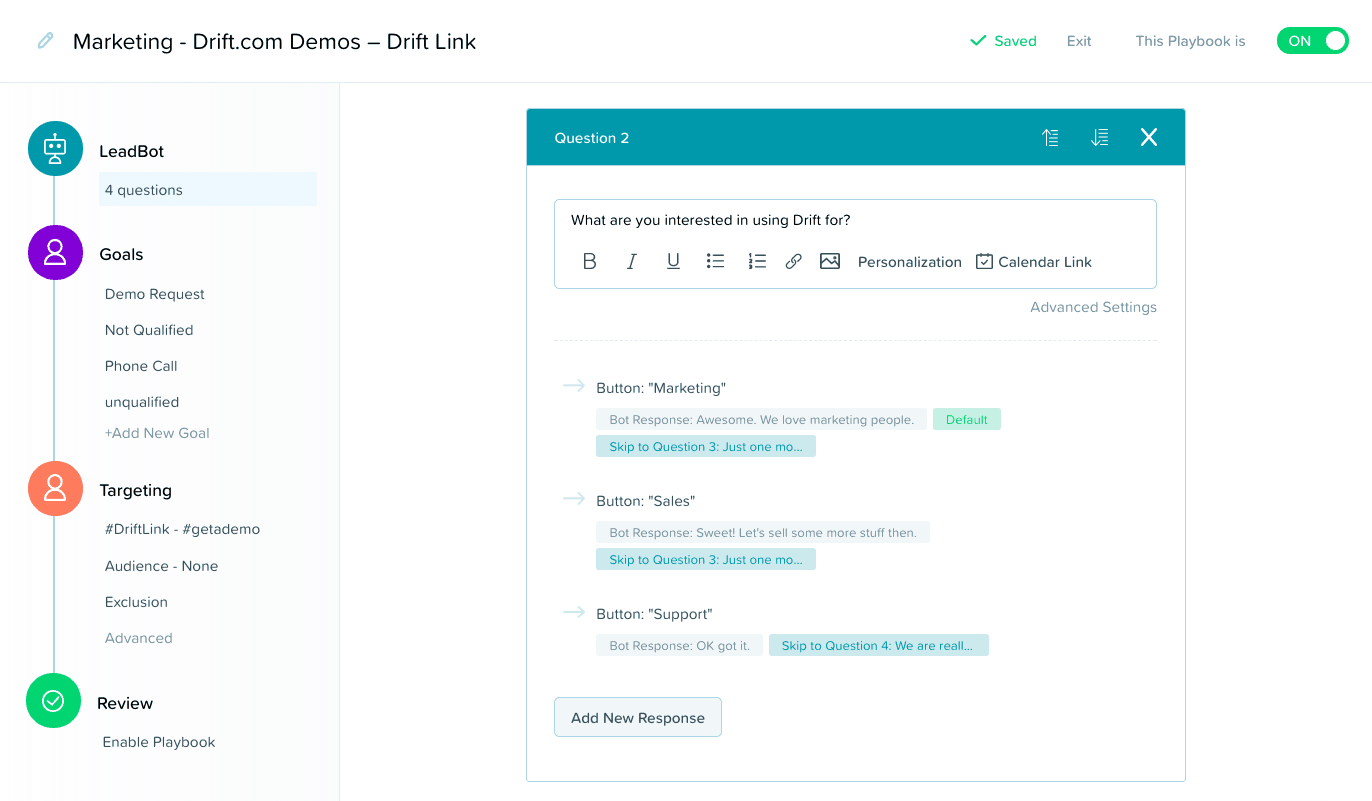
At Drift, because our product caters specifically to sales and marketing teams, we disqualify people who are only interested in using our product for support. Here’s the copy we use:
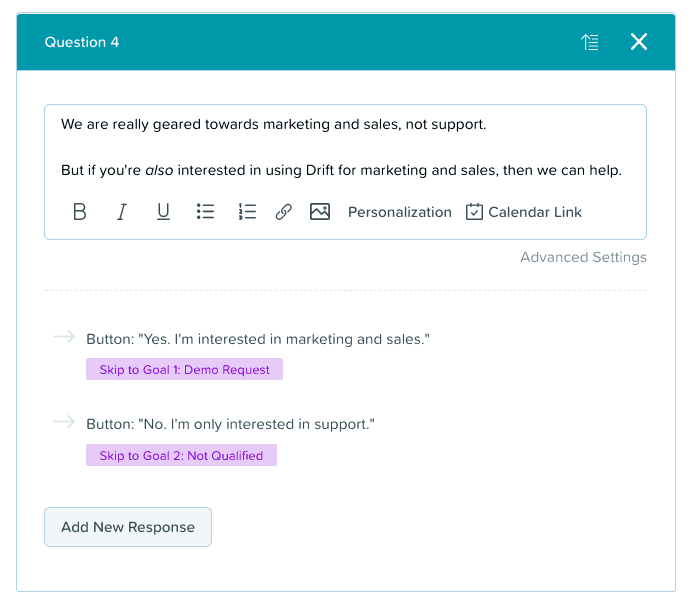
Once you’ve configured everything based on your company’s lead qualification criteria, the final step is setting up a custom #DriftLink that triggers your Playbook. For example, for our demo Playbook, we chose “#getademo” as our #DriftLink (see below).
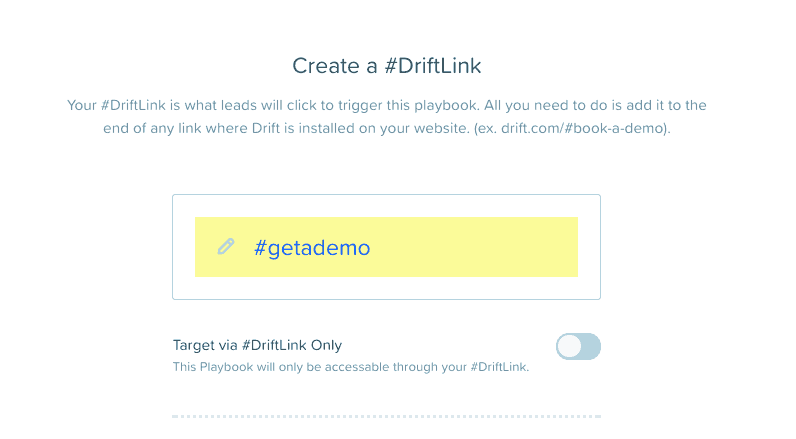
So to set this Playbook live on the Drift homepage, we just added #getademo to the end of our homepage URL (https://www.drift.com/#getademo) and then linked up our “Get a Demo” button.
Now, when someone clicks our “Get a Demo” button, they’re actually clicking our #DriftLink and triggering our “Get a Demo” Playbook.
2) The Fastlane
Where we run this Playbook:
- Across the Drift.com website
When it displays:
- When a visitor is a good fit based on our lead scoring model
If you’re a long-time reader of the Drift blog, chances are you’ve heard us use the term “fastlane” as a metaphor for how conversational marketing can speed up the buying process (and shorten sales cycles). Well, now we’ve taken that fastlane concept and turned it into an actual Drift Playbook.
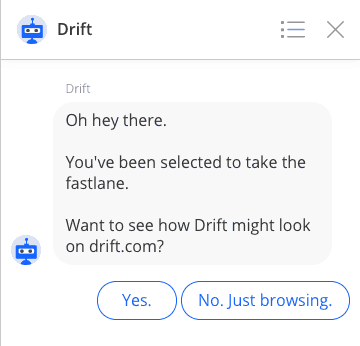
The Playbook targets just those website visitors who are a good fit to buy and connects them with our sales team. So instead of every visitor getting the same on-site welcome message and experiencing the same lead qualification process, we have a fastlane that lets our best leads skip to the front.
We’re able to do this using an integration we have with our friends at MadKudu. (They use machine learning to score website visitors and predict which ones are the most likely to buy.)
Here’s a sneak peek of what it looks like getting that set up in Drift:
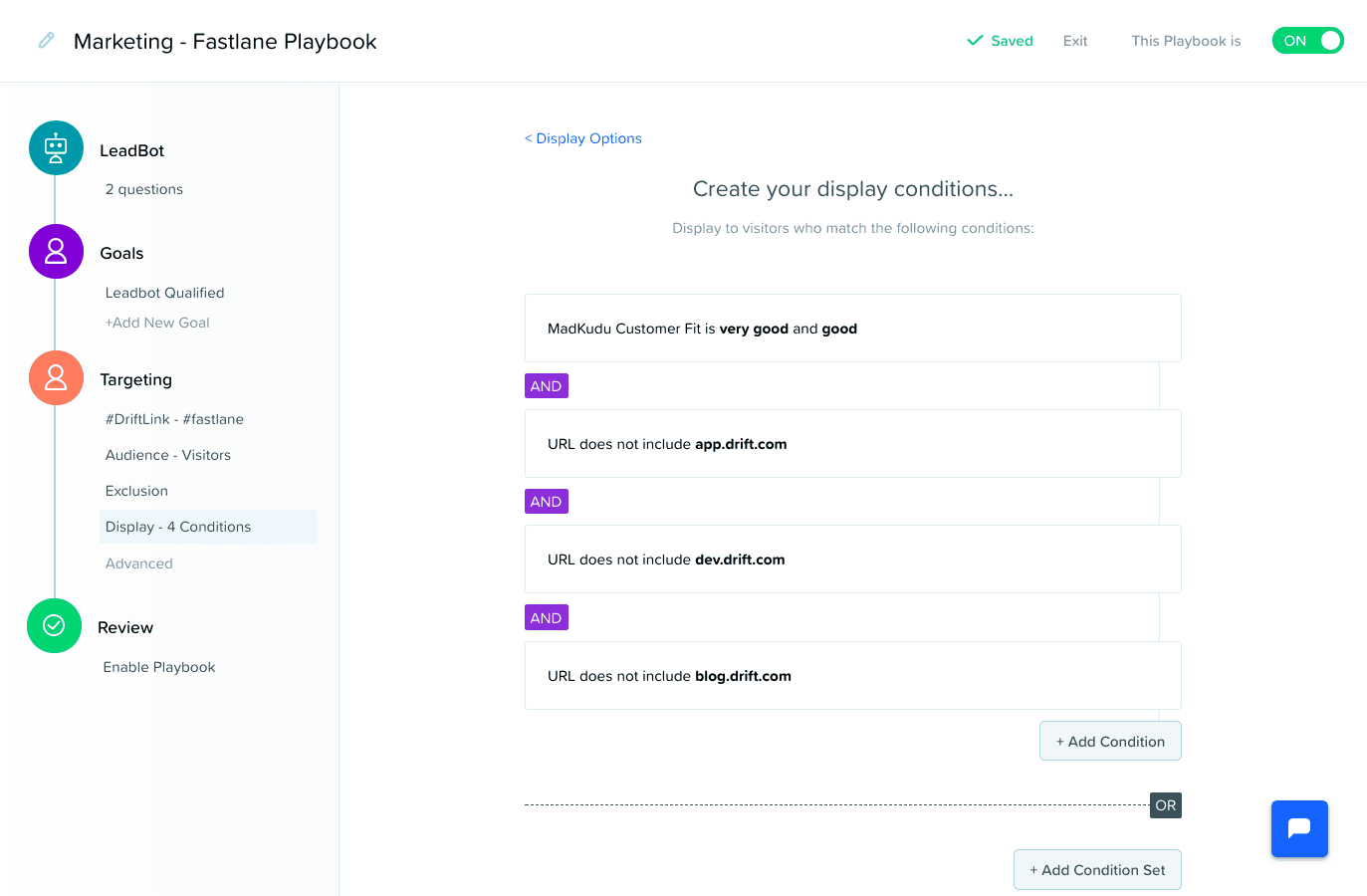
We also used our Clearbit integration to customize this Playbook based on a visitor’s IP address. That way, when a visitor enters the fastlane, we’re able mention their company’s domain name right in our message.
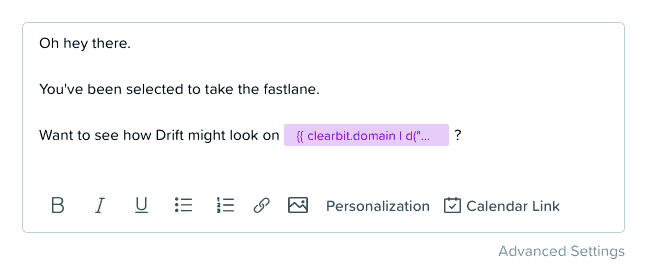
Now, for the bad news:
This Playbook is still in beta at the moment. But we’ll let you know as soon as it’s officially live!
3) Pricing Page
Where we run this Playbook:
- Yep, you guessed it: Our pricing page.
When it displays:
- Anytime someone visits that page.
The pricing page is one of — if not THE — highest-intent pages on your website. Chances are, if someone is snooping around on your pricing page, they could be interested in buying.
That’s why our “Pricing Page” Playbook was one of the very first Playbooks I ever set up. It appears proactively on our pricing page anytime someone drops by, and uses LeadBot to ask qualifying questions and book demos with our sales team.
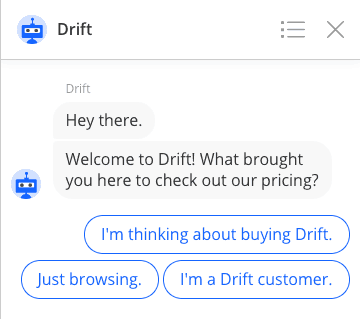
As far as setup goes, it’s the same formula I outlined in section #1 for our “Get a Demo” Playbook. Only because this is the pricing page, we don’t spend as much time with qualifying questions.
Instead, after asking what brought them here, we cut right to the chase and offer a demo to those visitors who say they’re “thinking about buying.”
Here’s the exact messaging we use:
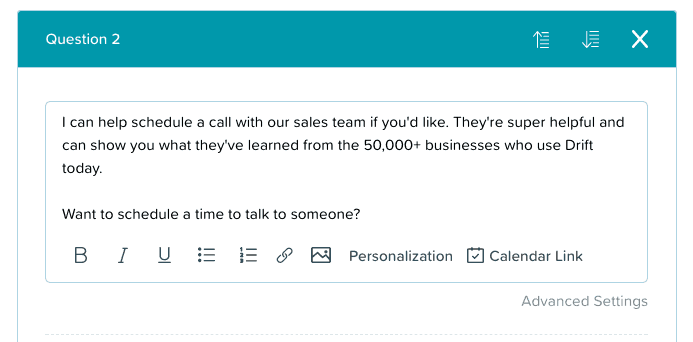
4) Powered By
Where we run this Playbook:
- On a dedicated “Powered By” page on Drift.com
When it displays:
- Anytime someone clicks our “⚡ by Drift” link at the bottom of a Drift conversation and lands on that page
If you use Drift, or have visited a site that has Drift on it, chances are you’ve seen the little watermark we stick at the bottom of our messaging widget:
![]()
In addition to helping us get the Drift brand out there, we’re also using this little watermark to drive people back to Drift.com. We’ve even set up a dedicated page just for those visitors who click it.
And with 50,000+ businesses displaying Drift on their sites, usually across multiple pages, a lot of people end up clicking our “⚡ by Drift” link. It’s become an important source of traffic for us.
To make sure we’re making the most of that traffic, and not letting any good leads slip through the cracks, we’ve set up a custom Playbook on our “Powered by” page that proactively appears and offers visitors a demo.
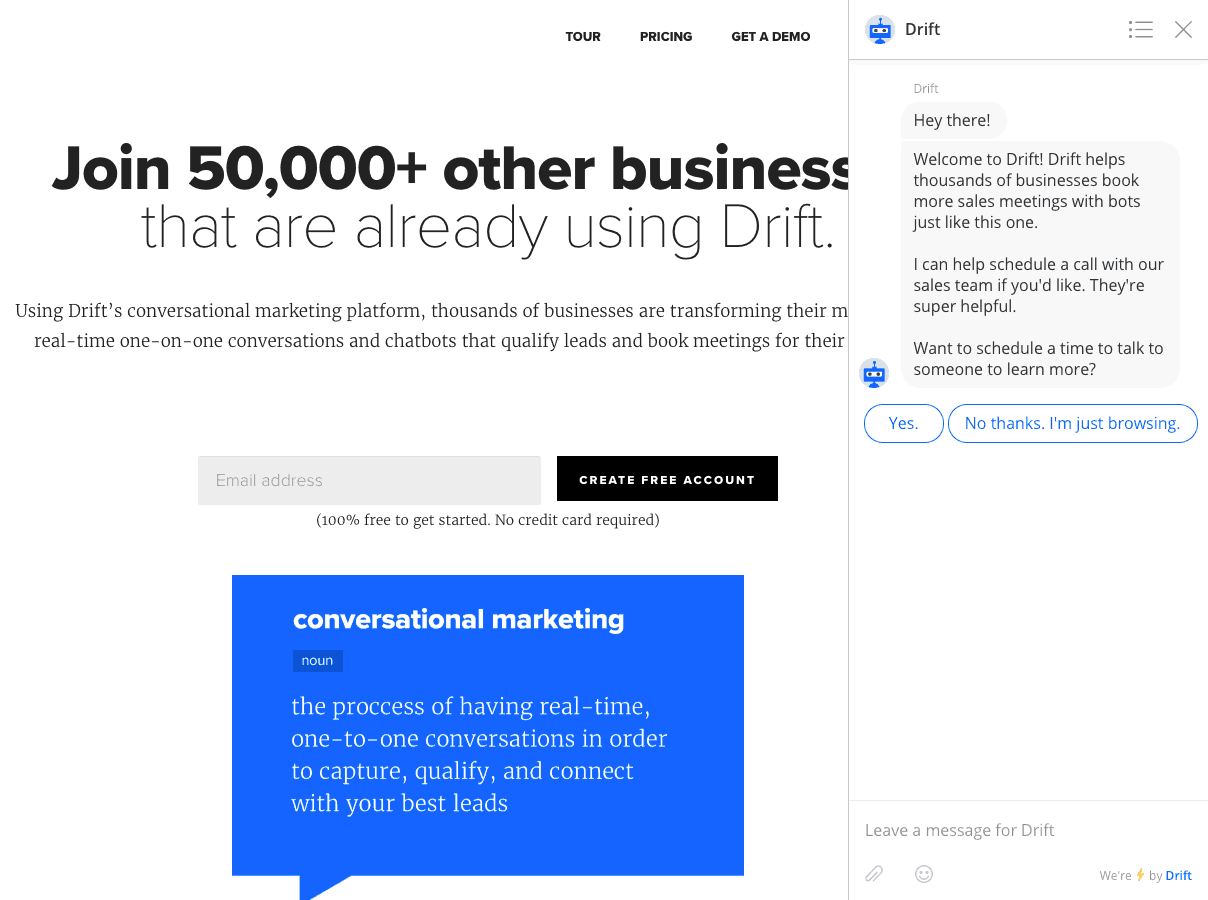
As was the case with the past few Playbooks we looked at, we started with the “Book a Qualified Meeting via LeadBot” template and then fine-tuned the messaging and targeting.
For this Playbook in particular, since it’s only running on a single page, the targeting was super simple (see below).
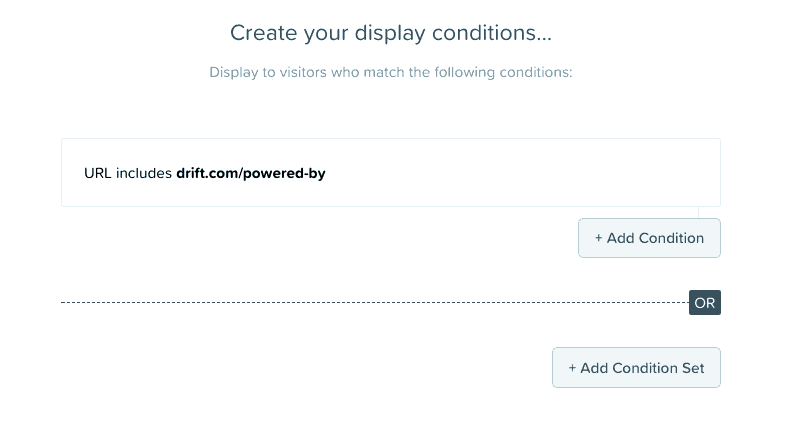
5) In-App Upgrade
Where we run this Playbook:
- On our billing page inside of the Drift app (app.drift.com)
When it displays:
- When a Drift user visits that page
This Playbook is based on the same philosophy (and uses the same basic setup) as the Playbook we run on our pricing page.
Only in this case, instead of targeting visitors who might be interested in buying, we’re targeting existing users and customers who might be interested in upgrading.

As you can see above, we run this Playbook on the billing page inside of our app, and it simply asks people if they’re interested in upgrading and want to be connected with someone to learn more.
If “Yes,” our LeadBot will route the conversation to a Drifter who can help and let the lead schedule a demo with them. If “No,” LeadBot will end the conversation.
Oh, right, and that’s something I haven’t really touched on yet: The way you set up those different outcomes in Drift is by creating Goals.
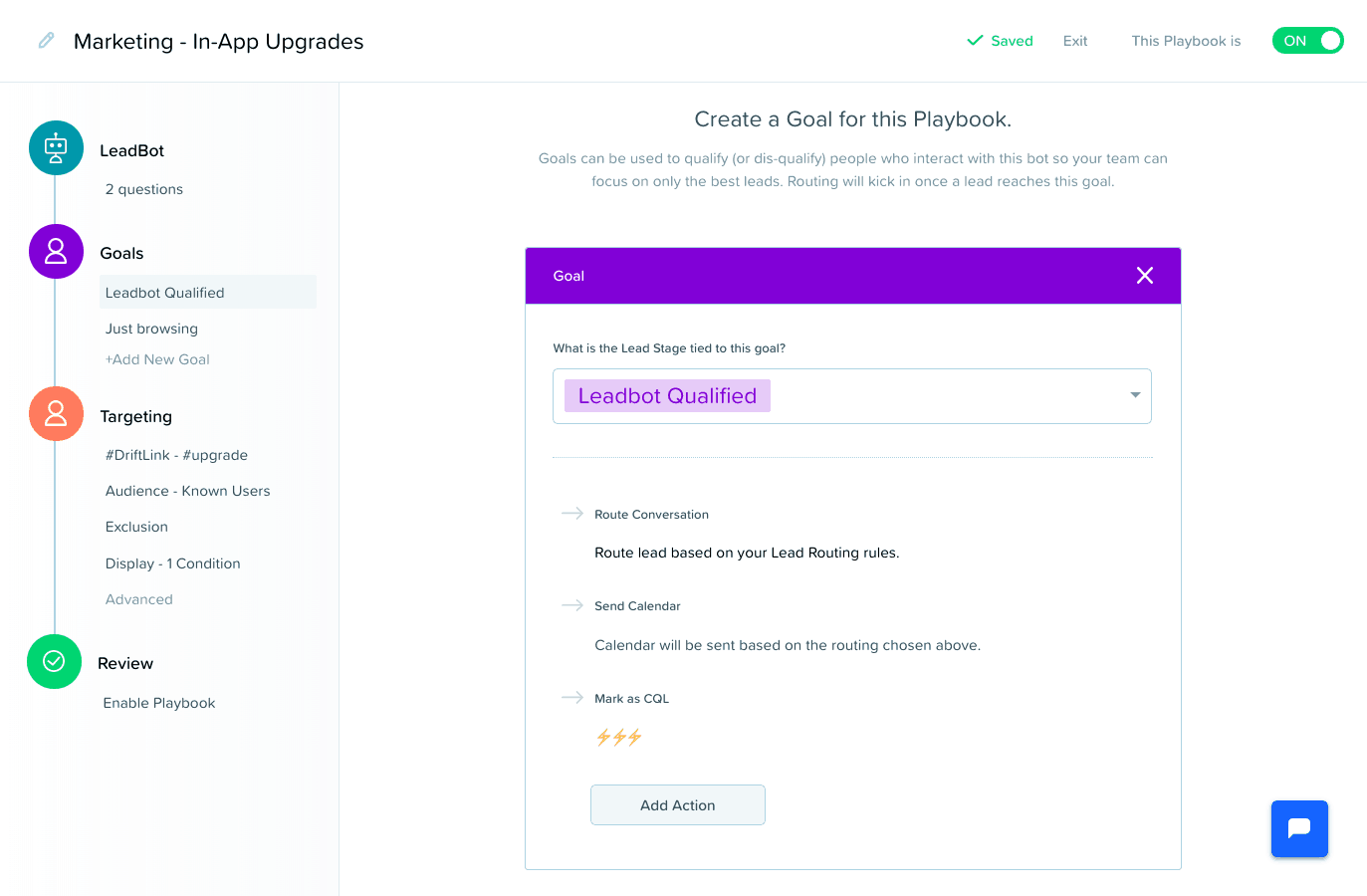
At Drift, one of our most common Goals is to get people qualified by LeadBot. That’s the event that sets everything in motion. Because once that Goal is met, that’s when routing kicks in and our sales team gets involved.
Or at least, that’s what happens when someone clicks “Yes” and ends up being qualified. When someone clicks “No, I’m just browsing,” a second Goal is met, and this one simply ends the conversation.
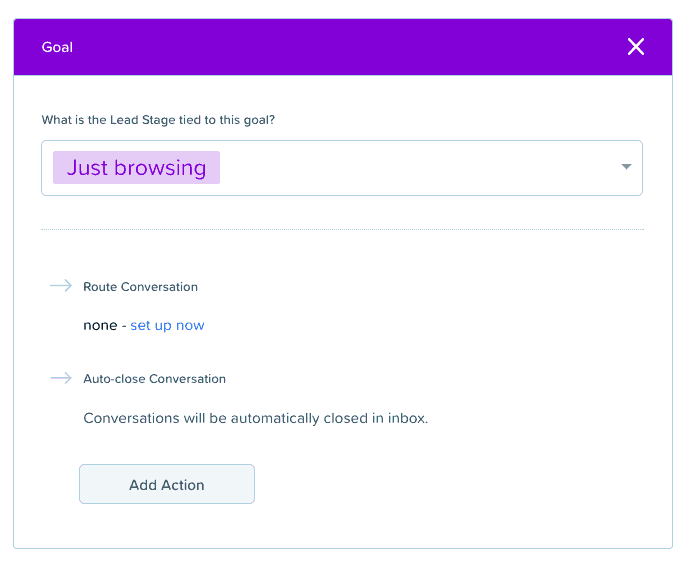
And FYI: You can control which responses get linked to which Goals when you’re setting up your qualifying questions.
For example, you can see that with this Playbook, our “Just browsing” Goal gets met as soon as someone clicks the “No, I’m just browsing,” button.
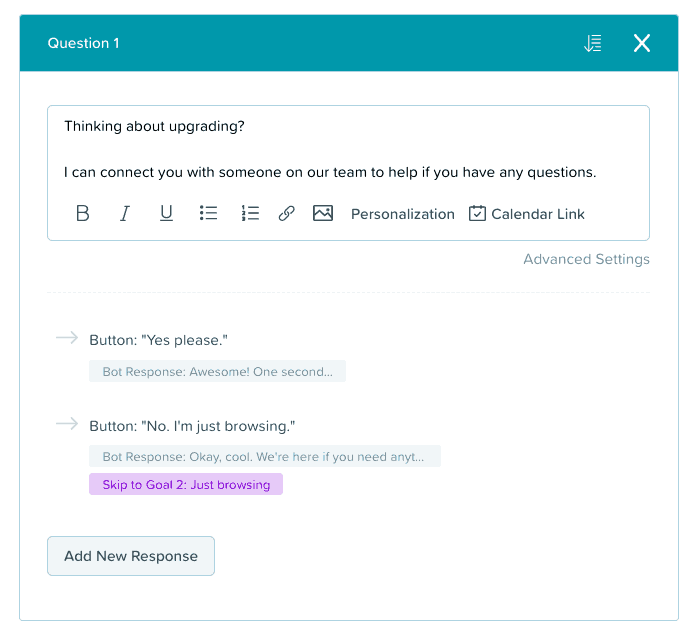
6) Subscriber List
Where we run this Playbook:
- On our blog (blog.drift.com)
When it displays:
- When a visitor who hasn’t subscribed to our newsletter visits the blog
We run two different Playbooks on the Drift blog, and this one targets the very top of the funnel: It’s a simple chatbot that asks people if they’d like to subscribe to get emails featuring our best content.
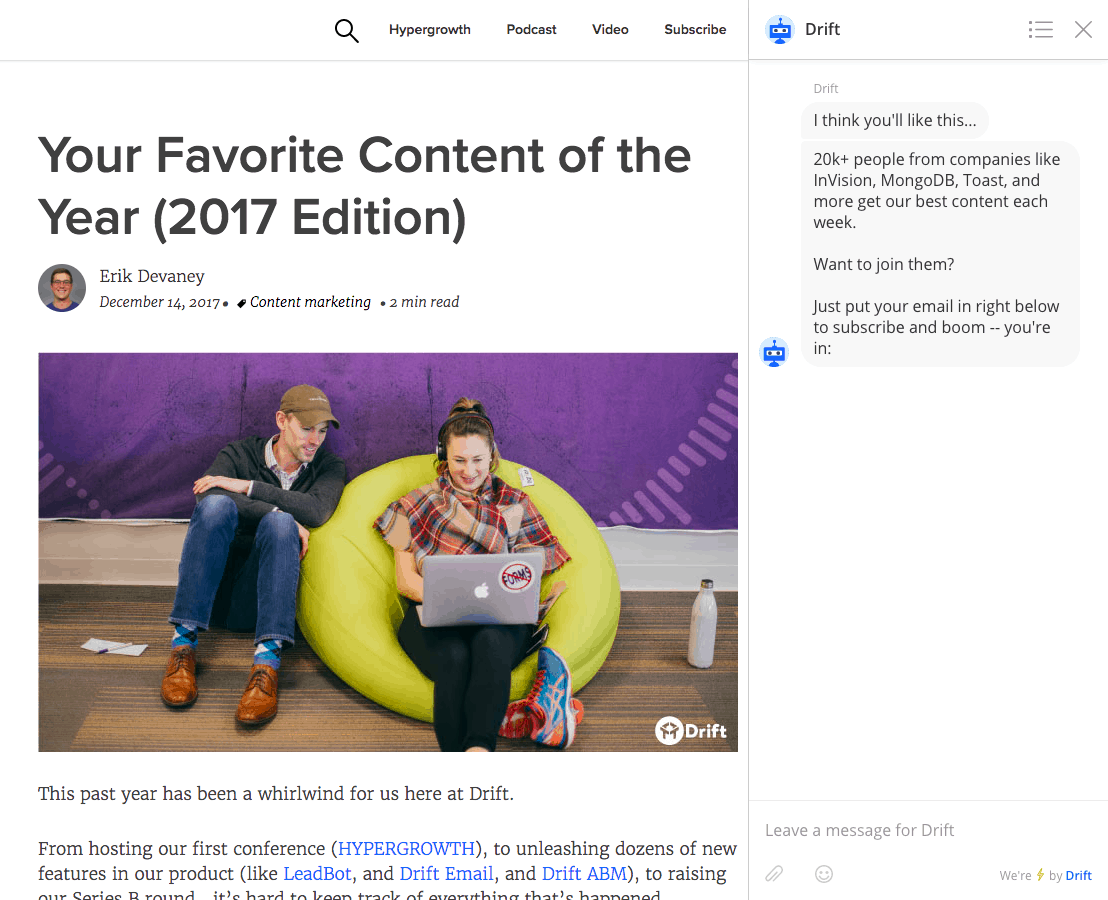
Instead of presenting people with a static email capture form, we have the bot pop up proactively and engage readers. As soon as an email is entered, it gets captured automatically.
And while we built this Playbook using LeadBot, you can also put together a super simple version of this same Playbook using our “Build a Blog Subscriber List” template. It accomplishes the same thing, only it doesn’t use bots (see screenshot below).
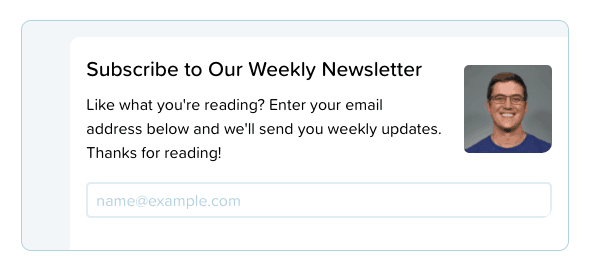
7) The Three-Visit Rule
Where we run this Playbook:
- On our blog (blog.drift.com)
When it displays:
- When a non-customer visits the blog on three separate occasions
This is the second Playbook we run on the Drift blog, and compared to our “Subscriber List” Playbook, it targets visitors who are further down our sales and marketing funnel.
Specifically, this Playbook appears to visitors who have dropped by the Drift blog on more than two separate occasions — the idea being if they keep coming back, maybe they’d be interested in learning more about our product?
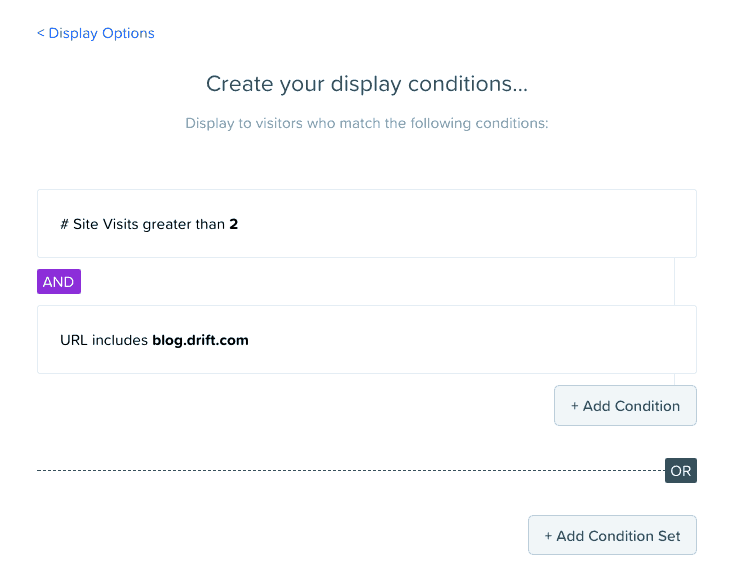
Here’s the exact copy we use in our “Three-Visit Rule” Playbook:
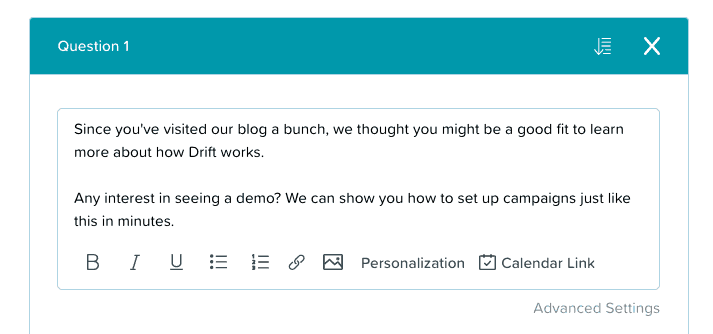
Note: For the full, step-by-step breakdown of how you can set this Playbook up on your own blog, check out this in-depth post that Erik wrote:
“This Is How We Generate Qualified Leads on the Drift Blog.”
8) Facebook Retargeting
Where we run this Playbook:
- Drift.com homepage
When it displays:
- When a visitor clicks-through on one of our Facebook ads
Truth be told: This isn’t a Playbook we run round the clock, but we will turn it on selectively. So I figured I’d give you the quick rundown.
First, we run retargeting ads on Facebook, which re-target website visitors who are not on paid plans.
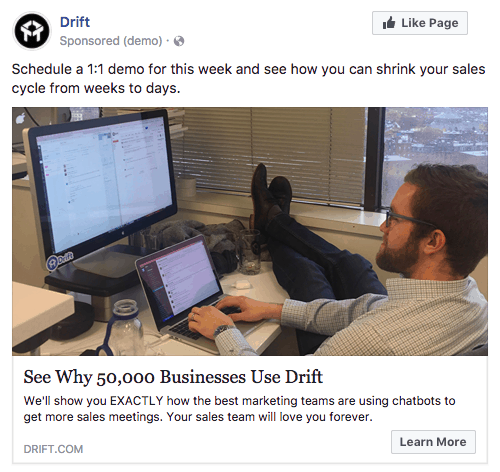
And because we hyperlink our ads with #DriftLinks (e.g. #facebook-demo), people automatically trigger the Playbook as soon as they click. So once they land on the Drift homepage, there’s a chatbot there to greet them and ask if they’d like to see a demo.
Final Thought
As we continue to unveil new features with each Marketable Moment, the approach we take and the Playbooks we use will continue to evolve.
So instead of thinking of this post as featuring the eight, set-in-stone tactics we’re using on the Drift website and will continue to use forever, think of this as a snapshot in time.
Moving forward, we’re going to keep changing and adapting to meet the needs of our customers and to match the way people prefer to buy.
But don’t worry: We’ll continue to write about everything we’re learning and, of course, we’ll continue to share all the secrets we uncover.



